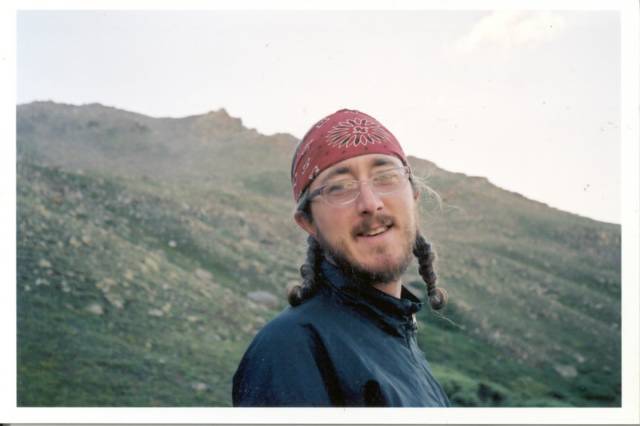28 Days in the Solu Khumbu - Part 2
We then descended and headed for Lobuche, which is the next-to-last town before Everest base camp. It was here that we saw how grim the main trekking route is. Lobuche is seriously filthy, with raw sewage about, nothing but hard-packed dust and none of the lodge-keepers seem happy to see you. Very few places to stay, and exhorbitant prices. One night here was enough, and we headed "around the corner" to a place called Dzongla for another night. Much nicer, but similarly expensive. We were gauging cost by a few "gold standards" - - how much one liter of hot water for your water bottle costs (cheaper and more environmental than buying bottled water) and how much popcorn costs per plate. In Kathmandu, one liter of water in a bottle costs 15 Rs (about 70 Rs to the USD) and popcorn is 30 Rs a plate. Boiled water high up in the Khumbu is 100 Rs a liter, and popcorn 100 Rs as well. When you first start, boiled water is about 40 Rs and popcorn maybe 40 Rs. Just some comparisons.
After Dzongla we headed for the Cho La, a very well-traveled pass that was a bit of a circus. It crosses a glacier at one point but is actually easy going. If the snow was fresh or maybe in the dead of winter it might be a problem, but as it was, no problem. Many people were decked out to the nines, though, clutching ice axes and wearing giant insulated over-boots. We even watched a guide cutting steps for people as we kick-stepped by the line of waiting people. Very interesting. Great rocks exposed there, too!
We dropped down and slogged for many more hours to arrive in Gokyo. Gokyo is really great. Situated next to a lake, it has a good view of the peak Cho Oyu and all the lodges have these great sun-rooms on top where you can sit and rest. We were beat after camping at such a height for a few days and then having a crappy rest at Lobuche and Dzongla. We took two solid days, ate plenty of dhal bhat, fried eggs and potatoes and read our books. Initially plans were made to hike around, but the sun-room caught us all and kept us happily enclosed.
Next was the Renjo La, and we got tremendous views back from where we has came and of Mt. Everest, etc. We found very interesting rocks at the pass and so delayed longer than we should have, leaving us to walk down the other side in a fog, looking for the porters. We managed to find them again at the small town of Arye, which had no facilites or lodges. We were now in the Bhote Valley, and a days walks south was the point that most trekkers do not walk past, the town of Thame. That night we ate dinner cooked by Dawa in a local family's personal tea room, which had an attached storage room with many blankets from Tibet and quite a few hanging dead animals.
The next day we walked to the "town" of Lunak, which is really a Tibetian ghost-town of deserted stone shacks and rings of old buildings. It was very windy in this narrow canyon sandwiched between the glacier on one side and high cliffs on the other. The next day we tried to hike to the Tibet-Nepal border, which turned into an ordeal. Not enough was eaten the night before and it was much further than we anticipated. The glacier is what really held us back. It is never direct, and the up and down, roundabout nature drains you fast. I turned back after seven hours of walking, knowing that I needed to keep a little energy to get back, but Micah and Dennis pushed on. I got back with the others who had turned back just at sunset, and the guys showed upa few hours later, well after dark. They made it to the border, although it is not much of a border - - no guards, no nothing, just the glacier and some prayer flags. They stared into the rolling hills of Tibet and turned back. The Nangpo La, as it is known, is a serious pass and yet the Tibetians drive their yaks over many times a month, carrying loads to Namche Bazaar. It is a hard route, and many yaks die - - we saw quite a few bodies and the trail is marked by yak blood drips and yak shit. Somehow they drive them over the sheer ice and crazy structures we carefully walked over and up and over.
After that long day we were ready to begin dropping back down and head for Namche Bazaar and all the sticky buns we could eat. The Bhote Valley is beautiful, and the two day walk was fantastic, especially once we dropped back down below the tree line and started walking through the rhododendron forests.
Another full rest day in Namche saw us eating as many calories as possible and then we made the one day push to Lukla to fly out.
Now what? Well, it looks like India for me. I am tired of stomping through the mountains, actually! Months of mountain-time this summer and then a hard month in the Khumbu has left me wanting warmer climates, so it is south I go! Tomorrow I will buy a ticket for Varanasi, the city on the Ganges where Hindus strive to go and die. Crematorium central. Or, if you are to poor to be burned, they just toss you in. No swimming for me . . .
I'll let you all know as soon as I buy the ticket!



0 Comments:
Post a Comment
<< Home